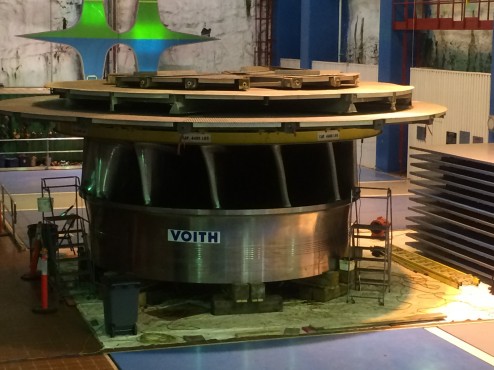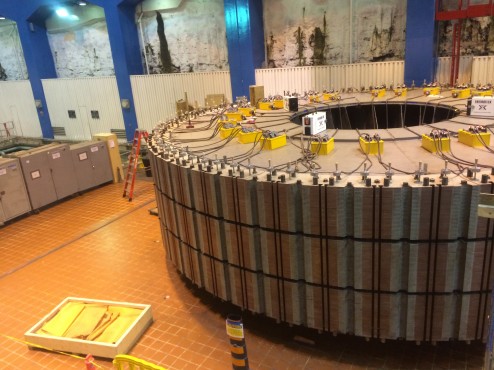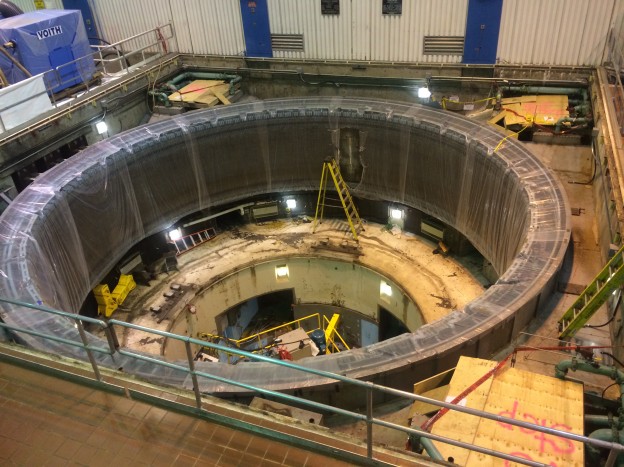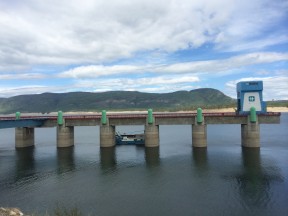We donned our hard hats and safety vests and toured the inner working of the dam creating the 3rd largest artificial lake in North America, Williston Lake. It is so large it took 55 million cubic feet of dirt to build the dam and five years to fill the lake with inflow from two rivers after the dam was installed. We lucked out and toured the facility while one side of the powerhouse was shut down and wide open for installation of new rotors (feature image). The powerhouse is buried sixty stories under ground and from bottom to top is almost as tall as the Eiffel Tower. The transmission station is on the surface as we stand on the top of the 610 foot tall dam, all the more amazing as it must be both 1/2 mile wide at the bottom to support both the slender road 1/2 mile road along the top of the dam, and the weight of the water.
The dam’s 10 turbines generate more than 13 billion kWh annually. To put this in perspective, our 1100 sq. ft. roof in Albany, CA is covered in solar panels and generates 1800 kWh annually; we generate enough electricity to meet our needs and still sell back electricity to the utility company. However, unlike Canadians, we don’t need electricity to survive freezing winter temperatures and darkness between 2 PM and 9 AM.
 If all ten turbines ran at the same time 1.4 million litres of water surge into the turbine runners (water wheels like the one above) using 93% of the dedicated water to turn huge shafts that then spin the electricity producing rotors in the photo below.
If all ten turbines ran at the same time 1.4 million litres of water surge into the turbine runners (water wheels like the one above) using 93% of the dedicated water to turn huge shafts that then spin the electricity producing rotors in the photo below.
 The water is released to flow down the Peace River to another hydroelectric station with six turbines, and then onward to the Arctic Ocean. As this dam produces 40% of British Columbia’s energy needs, and is renewable, the cost to build and maintain the dam seems negligible compared to the benefit…unless you value the plant and animal biodiversity destroyed by flooding 375,000 acres of prime forest. Also the displacement of the Tsay Keh Dene First Nations residents, the Ingenika, caused, “Isolation, alienation, dependence and illness”, clearly severe environmental impact. At least Canada paid the Aboriginals a $15 million lump sum and a $1.6 million inflation adjusted annual payment. Although that creates dependence and dislocation, I wish we, our US federal government, had at least tried to contribute fairly to our displaced tribes, instead we gave them the genocide called the Trail of Tears, the massacre at Wounded Knee, and life on “The Rez”, eg. chronic poverty, alcoholism, disease, and such crummy quality land that casinos are the only way to make a living on most Native American Indian reservations. Shame on us.
The water is released to flow down the Peace River to another hydroelectric station with six turbines, and then onward to the Arctic Ocean. As this dam produces 40% of British Columbia’s energy needs, and is renewable, the cost to build and maintain the dam seems negligible compared to the benefit…unless you value the plant and animal biodiversity destroyed by flooding 375,000 acres of prime forest. Also the displacement of the Tsay Keh Dene First Nations residents, the Ingenika, caused, “Isolation, alienation, dependence and illness”, clearly severe environmental impact. At least Canada paid the Aboriginals a $15 million lump sum and a $1.6 million inflation adjusted annual payment. Although that creates dependence and dislocation, I wish we, our US federal government, had at least tried to contribute fairly to our displaced tribes, instead we gave them the genocide called the Trail of Tears, the massacre at Wounded Knee, and life on “The Rez”, eg. chronic poverty, alcoholism, disease, and such crummy quality land that casinos are the only way to make a living on most Native American Indian reservations. Shame on us.


